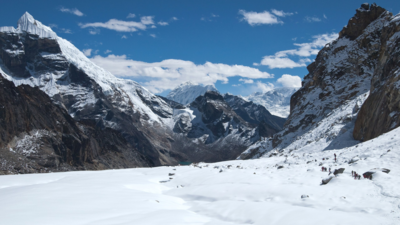- News
- Science News
- How a warming Himalaya could affect billions of people
How a warming Himalaya could affect billions of people
The Himalayas, Asia's crucial water source, face a severe crisis as snowfall hits a 23-year low, impacting nearly two billion people. Declining snow persistence threatens agriculture, water supplies, and hydroelectric power across major Asian river systems. Urgent action is needed, including regional cooperation, improved water management, and reduced emissions, to mitigate the far-reaching consequences of this climate emergency.
The majestic Himalayas, often called the “Water Tower of Asia,” are undergoing a drastic transformation. As the Earth warms, so do the towering peaks of the Hindu Kush-Himalayan (HKH) range, and the consequences could be catastrophic for nearly two billion people who rely on its snow and ice.
Recent data from the International Centre for Integrated Mountain Development (ICIMOD) paints a stark picture: snowfall in the HKH region during the winter of 2024-25 plummeted to its lowest in 23 years. Snow persistence, the duration snow remains on the ground, was 23.6 percent below normal. This marks the third consecutive year of decline and signals a dangerous shift in the region’s hydrology.
How the melting of Himalayas could affect agriculture and water supplies
The Himalayas feed 12 of Asia’s major river systems, including the Ganga, Indus, Brahmaputra, Mekong, and Amu Darya. Snowmelt from these mountains sustains agriculture, drinking water supplies, and hydroelectric power across countries such as India, China, Pakistan, Nepal, and Bangladesh. When snowfall declines, so does the water available to millions downstream.
What is causing this enormous meltdown
The shrinking snow cover is a direct fallout of climate change. The Himalayas are warming faster than the global average, driven by both global emissions and local changes such as urban sprawl and land-use transformation. A 2019 ICIMOD report warned that even if global warming is kept within 1.5°C as per the Paris Agreement, the HKH region will still warm by 0.3°C, triggering irreversible changes.
Shifting snowfall patterns are being influenced by weaker western disturbances and disruptions in storm systems from the Mediterranean, further unsettling the region’s delicate climatic balance.
A call for urgent action
In response to these warnings, the path forward demands a two-pronged strategy: mitigation and adaptation. Policymakers need to invest in better water management, drought-proofing agriculture, and upgrading early warning systems. More importantly, regional cooperation must be strengthened.
The ICIMOD report calls on HKH nations to share data on river flows, establish joint alert systems for floods and droughts, and develop an interconnected renewable energy grid to reduce dependency on glacial waters.
However, the politics of water-sharing in South Asia are fraught with complexity. Riparian disputes and national interests often hinder collaboration. Yet, as glaciers shrink and snow becomes scarcer, the cost of inaction will far outweigh the challenges of cooperation.
The way ahead
The melting Himalayas are not just a regional crisis. They are a global climate emergency in the making. The lives and livelihoods of billions depend on the resilience of this high-altitude ecosystem. What happens in the Himalayas will ripple across Asia and beyond.
As the peaks lose their snowy crowns, humanity must act, not just to protect a mountain range, but to secure the future of nearly a quarter of the world’s population.

About the Author
TOI Science DeskEnd of Article
Follow Us On Social Media

